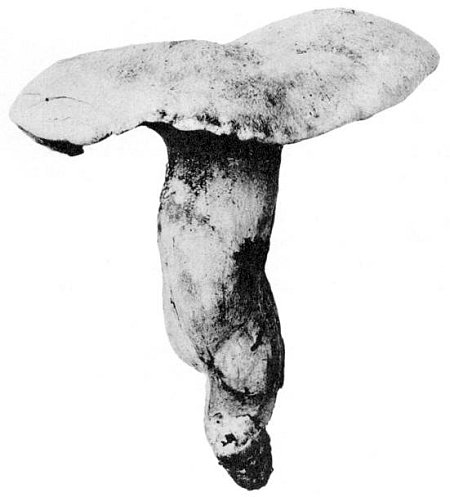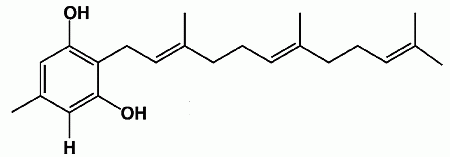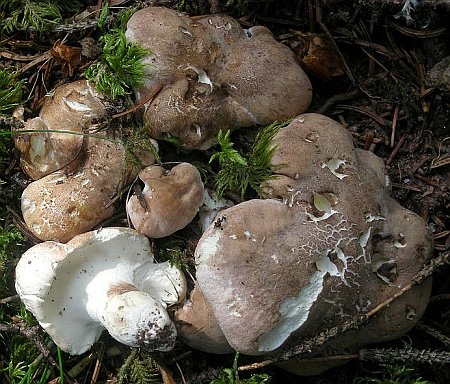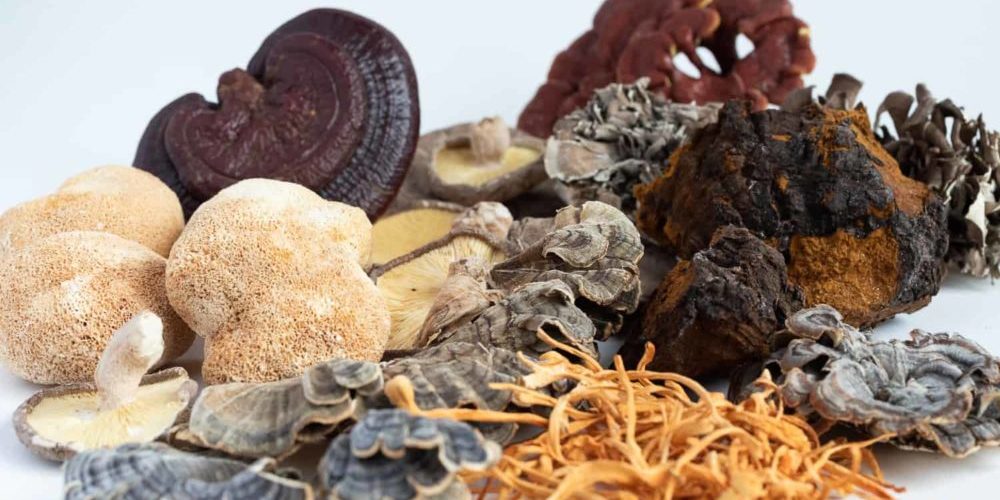Classification
Kingdom Fungi
Phylum Basidiomycota
Class Basidiomycetes
Order Polyporales
Family Albatrellaceae
Genus Albatrellus
Although Stalpers (1992) placed the genus into the family Scutigeraceae (in the Cantharellales), his suggested revision doesn’t seem to have caught on, despite corroborating evidence based on ectomycorrhizae morphology (Agerer et al., 1996). Index Fungorum and Cannon and Kirk (2007) (my usual authorities on these matters) list the family as Albatrellaceae.
Synonyms
Boletus carinthiacus Pers.
Syn. meth. fung. (Göttingen): 514 (1801)
Boletus fragilis Pers.
Observ. mycol. (Lipsiae) 1: 84 (1796)
Boletus ovinus Schaeff.
Fung. Bavar. Palat. 4: 83 (1774)
Caloporus ovinus (Schaeff.) Quél.
Enchir. fung. (Paris): 164 (1886)
Polyporus limonius Velen.
České Houby 4-5: 668 (1922)
Polyporus lutescens Velen.
České Houby 4-5: 669 (1922)
Polyporus ovinus (Schaeff.) Fr.
Syst. mycol. (Lundae) 1: 346 (1821)
Polyporus subsquamosus var. luteolus Beck
Verh. zool.-bot. Ges. Wein 36: 469 (1886)
Scutiger ovinus (Schaeff.) Murrill
Mycologia 12(1): 20 (1920)
Common names
Sheep polypore
Ningyoutakemodoki (Japanese)

My name is Austin Collins.
I've dedicated my life to Mushrooms.
I believe Mushrooms are the best kept secret when it comes to health and well being.
For that reason, I would like to share a company with you that in my opinion makes the best mushroom products on the market.
The company is called Noomadic Herbals, my favorite supplement they make is called "Mushroom Total".
I take their products every day and they have helped me think better and have more energy. Give them a try.
-Austin
Description
Cap: 4-14 cm diameter, 3-10 mm thick, fleshy, circular, convex; surface initially tomentose, white or tan-colored, becoming areolate, or subsquamulose in age; drying fawn color and black-spotted; margin acute, even or undulating, concolorous or blackish, inflexed on drying, sterile below; context at first white, drying light pinkish cinnamon, usually containing a black line adjacent to the tubes, 1-6 mm thick.
Tubes: decurrent, at first whitish, drying tawny to chestnut brown, 1-3 mm long; mouths angular, concolorous with the tubes, 2-3 per mm.
Stem: 2-7 cm long x 1-2 cm thick, central, solid, usually with a bulbous base, tomentose, at first whitish to tan-colored, drying light vinaceous-cinnamon to clay color, often black-spotted.
Spores: subglobose, hyaline, smooth, 3.0-4.5 x 2.5-3 µm.
Habitat: on the ground in coniferous forests in temperate and boreal climates; mycorrhizal; appearing late summer and autumn.

Credit: C.G. Lloyd
Source: Shope (1931) (Public Domain).
Bioactive compounds
Polysaccharides
The polysaccharide fraction from the hot water extract of A. ovinus has been studied (Axelsson and Björndal, 1969). The fucogalactan was shown to consist of chains of (1→6)-linked D-galactopyranose residues, 25% of which are substituted in the 2-position, as in the structure below:

A number of phenolic compounds have been isolated from A. ovina, including the novel neogrifolin derivatives 3-hydroxyneogrifolin, 1-formylneogrifolin and 1-formyl-3-hydroxyneogrifolin along with grifolin and neogrifolin (Besl et al., 1977; Vrkoč et al., 1977; Nukata et al., 1996), scutigeral, ilicicolin B, ovinal and ovinol (Dekermendjian et al., 1997). Some of these prenylphenols are shown below:

Grifolin: 2-trans, trans-farnesyl-5-methylresorcinol. This compound is revealing itself to have some promising medicinal properties, described below. After the first report of its antibiotic properties by Hirata and Nakanishi (1950), followed its structure (Goto et al., 1963), and finally its syntheses (Isobe and Goto, 1968; Ohta et al., 1988).



Medicinal properties
Antioxidant activity
The neogrifolin derivatives 3-hydroxyneogrifolin and 1-formyl-3-hydroxy-neogrifolin were found to be more potent antioxidants than either α-tocopherol or BHA (Nukata et al., 2002).
Dopamine D1 receptor binding/Vanilloid receptor modulation
Dopamine, a neurotransmitter in the central nervous system, is also an important peripheral physiological regulator. There are at least 5 subtypes of dopamine receptors distributed in various tissues of the body. All of the triprenyl phenols isolated from fruiting bodies of A. ovinus (namely, grifolin, neogrifolin, scutigeral, ilicicolin B, ovinal, and ovinol) inhibit binding of 3H-SCH 23390 (a dopamine D1 receptor ligand) to the dopamine D1 receptor subfamily in rats. The most potent of these compounds was scutigeral (IC50 of 2.6 µM), which was shown to decrease the binding affinity of 3H-SCH 23390 in a competitive manner (Dekermendjian et al., 1997).
A study of CNS receptor pharmacology showed that scutigeral roughly mimics capsaicin, the irritant in hot pepper (Szalli et al., 1999). These authors concluded that scutigeral and related chemical compounds (ie., the triphenyl phenols) represent a promising new class of vanilloids – chemicals that interact with and modulate the effect of vanilloid receptors in humans. Desensitization of sensitive neuronal pathways by vanilloids is exploited in therapies for various diseases such as hypertension, inflammation and organ damage (Wang, 2008). However, later investigation using electrophysiological recordings on rat neurons and a VR1 luminescence assay with a recombinant cell line showed no evidence of agonist-like activity for the fungal vanilloids. Rather, it suggested fungal prenylphenols like grifolin and neogrifolin worked by directly inhibiting receptor activity (as weak antagonists), rather than desensitizing it, as suggested by Szalli et al.
Grifolin added to a high cholesterol diet fed to rats was found to significantly lower plasma cholesterol levels, with limited or no toxicity (Sugiyama et al., 1992)
Also, in a screening assay of natural compounds for nuclear receptor agonists, grifolin was found to upregulate the expression of the reporter gene for the farnesoid X receptor, FXR (Suzuki et al., 2006). This is of interest because FXR controls the expression of critical genes in bile acid and cholesterol metabolism, making it an attractive pharmacological target for the treatment of hyperlipidemia.
Grifolin is known to be antibacterial towards the Gram-positive bacteria Staphylococcus aureus (1:180,000) and Bacillus subtilis (1:180,000), measured using the agar streak method. Also, it inhibits the growth of the acid-fast Mycobacterium avium and Mycobacterium phlei. Furthermore, the toxicity of grifolin is low (lethal dose for mice 1.6 gm/kg body weight), and the antibacterial activity is heat-stabile up to 93ºC (Hirata and Nakanashi, 1950)
Polysaccharides extracted from the mycelial culture of A. ovinus and administered intraperitoneally into white mice at a dosage of 300 mg/kg inhibited the growth of both Sarcoma 180 and Ehrlich solid cancers by 100% (Ohtsuka et al., 1973).
Grifolin has been shown to strongly inhibit the growth of the various cancer cell lines below (Ye et al., 2005):
- CNE1 (human nasopharyngeal carcinoma)
- HeLa (human cervical cancer)
- MCF7 (human breast cancer)
- SW480 (human colon cancer)
- K562 (human chronic myelogenous leukemia)
- Raji (human Burkitts Lymphoma)
- B95-8 (marmoset B lymphoblastoid)
This study also showed that grifolin induced apoptosis in CNE1, HeLa, MCF7 and SW480. Later work revealed that, at least in the CNE1 cell line, grifolin works by inhibiting the ERK1/2 or the ERK5 pathway, inducing cell-cycle arrest in the G1 phase of cell growth (Ye et al., 2007). Grifolin also inhibited the growth of and induced apoptosis in the osteosarcoma cell lines U2OS and MG63 (Jin et al., 2007).
Grifolin and neogrifolin exhibited inhibitory activity against nitric oxide (NO) production stimulated by lipopolysaccharide (LPS) in RAW 264.7 cells with IC50 values of 29.0, and 23.3 µM, respectively (Quang et al., 2006). Since the overproduction of NO has been implicated in various pathological processes (e.g., septic shock, tissue damage following inflammation, rheumatoid arthritis), drug-induced suppression of NO production may be useful for the treatment of inflammatory diseases.
Links
References
Agerer R, Klostermeyer D, Steglich W, Franz F, Acker G.
Ectomycorrhizae of Albatrellus ovinus (Scutigeraceae) on Norway Spruce with some remarks on the systematic position of the Family.
Mycotaxon. 1996 59:289-307.
Axelsson K, Bjorndal H.
Polysaccharides elaborated by Polyporus ovinus (Schaeff) .I. Structure of a fucogalactan from water extracts of fruit bodies.
Acta Chem Scand. 1969 23(5):1815-7.
Besl H, Hoefle G, Jendrny B, Jaegers E, Steglich W.
Fungus pigments part 31. Farnesyl phenols from Albatrellus-spp Basidiomycetes.
Chemische Berichte. 1977 110(12):3770-6.
Cannon PF and Kirk PM. (2007)
Fungal Families of the World.
United Kingdom: CABI. 456 pp.
Dekermendjian K, Shan R, Nielsen M, Stadler M, Sterner O, Witt MR.
The affinity to the brain dopamine D-1 receptor in vitro of triprenyl phenols isolated from the fruit bodies of Albatrellus ovinus.
Eur J Med Chem. 1997 32(4):351-6.
Goto T, Kakisawa H, Hirata Y.
The structure of grifolin, an antibiotic from a basidiomycete.
Tetrahedron. 1963 19(12):2079-83
Hellwig V, Nopper R, Mauler F, Freitag J, Liu JK, Ding ZH, Stadler M.
Activities of prenylphenol derivatives from fruitbodies of Albatrellus spp. on the human and rat vanilloid receptor 1 (VR1) and characterisation of the novel natural product confluentin.
Archiv Der Pharmazie 2003 336(2):119-26.
Hirata Y, Nakanashi K.
Grifolin, an antibiotic from a basidiomycete.
J Biol Chem. 1950 184(1):135-43.
Isobe M, Goto T.
Synthesis of grifolin, an antibiotic from a Basidiomycete.
Tetrahedron. 1968 24(2):945-8.
Jin S, Pang RP, Shen JN, Huang G, Wang J, Zhou JG.
Grifolin induces apoptosis via inhibition of PI3K/AKT signalling pathway in human osteosarcoma cells.
Apoptosis. 2007 12(7):1317-26.
Jorhem L, Sundstrom B.
Levels of some trace elements in edible fungi.
Z Lebensm Unters Forsch. 1995 201(4):311-6.
Nukata M, Yamamoto I, Sasaki K.
Antioxidative substances from several mushrooms.
Nippon Nogeikagaku Kaishi. 1996 70:58.
Nukata M, Hashimoto T, Yamamoto I, Iwasaki N, Tanaka M, Asakawa Y.
Neogrifolin derivatives possessing anti-oxidative activity from the mushroom Albatrellus ovinus.
Phytochemistry. 2002 59(7):731-7.
Ohta S, Nozaki A, Ohashi N, Matsukawa M, Okamoto M.
A total synthesis of grifolin.
Chem Pharm Bull (Tokyo). 1988 36(6):2239-43.
Ohtsuka S, Ueno S, Yoshikumi C, Hirose F, Ohmura Y, Wada T, Fujii T, Takahashi E.
Polysaccharides having an anticarcinogenic effect and a method of producing them from species of Basidiomycetes.
UK Patent 1331513, 26 September 1973.
Quang DN, Hashimotoa T, Arakawaa Y, Kohchib C, Nishizawab T, Somab G-I, Asakawaa Y.
Grifolin derivatives from Albatrellus caeruleoporus, new inhibitors of nitric oxide production in RAW 264.7 cells.
Bioorg Med Chem. 2006. 14(1):164-8.
Restivo JH.
Nuclear division and behavior in the basidia of Polyporus ovinus basidiomycete.
ASB Bulletin. 1975 22(2):74.
Ryman S, Fransson P, Johannesson H, Danell E.
Albatrellus citrinus sp. nov., connected to Picea abies on lime rich soils.
Mycol Res. 2003 107(Pt 10):1243-6.
Shope PF.
The Polyporaceae of Colorado.
Annals of the Missouri Botanical Garden. 1931 18(3):287-456.
Stalpers JA.
Albatrellus and the Hericiaceae.
Persoonia. 1992 Supplement 14:537–41.
Sugiyama K, Kawagishi H, Tanaka A, Saeki S, Yoshida S, Sakamoto H, Ishiguro Y.
Isolation of plasma cholesterol-lowering components from ningyotake (Polyporus confluens) mushroom.
J Nutr Sci Vitaminol. 1992 38:335–342.
Sugiyama K, Tanaka A, Kawagishi H, Ojima F, Sakamoto H, Ishiguro Y.
Hypocholesterolemic action of dietary grifolin on rats fed with a high-cholesterol diet.
Biosci Biotechnol Biochem. 1994 58(1):211-2.
Suzuki T, Nishimaki-Mogami T Kawai H, Kobayashi T, Shinozaki Y, Sato Y, Hashimoto T, Asakawa Y, Inoue K, Ohno Y, Hayakawa T, Kawanishi T.
Screening of novel nuclear receptor agonists by a convenient reporter gene assay system using green fluorescent protein derivatives.
Phytomedicine (Jena). 2006 13(6):401-11.
Szallasi A, Biro T, Szabo T, Modarres S, Petersen M, Klusch A, Blumberg PM, Krause JE, Sterner O.
A non-pungent triprenyl phenol of fungal origin, scutigeral, stimulates rat dorsal root ganglion neurons via interaction at vanilloid receptors.
Br J Pharmacol. 1999 126(6):1351-8.
Vrkoč J, Budesinsky M, Dolejs L.
Phenolic meroterpenoids from basidiomycete Albatrellus ovinus.
Phytochem. 1977 16(9):1409-11.
Wang DH.
Transient receptor potential vanilloid channels in hypertension, inflammation, and end organ damage: an imminent target of therapy for cardiovascular disease?
Curr Opin Cardiol. 2008 23(4):356-63.
Ye M, Liu JK, Lu ZX, Zhao Y, Liu SF, Li LL, Tan M, Weng XX, Li W, Cao Y.
Grifolin, a potential antitumor natural product from the mushroom Albatrellus confluens, inhibits tumor cell growth by inducing apoptosis in vitro.
FEBS Lett. 2005 579(16):3437-43.
Ye M, Luo X, Li L, Shi Y, Tan M, Weng X, Li W, Liu J, Cao Y.
Grifolin, a potential antitumor natural product from the mushroom Albatrellus confluens, induces cell-cycle arrest in G1 phase via the ERK1/2 pathway.
Cancer Lett. 2007 258(2):199-207.



